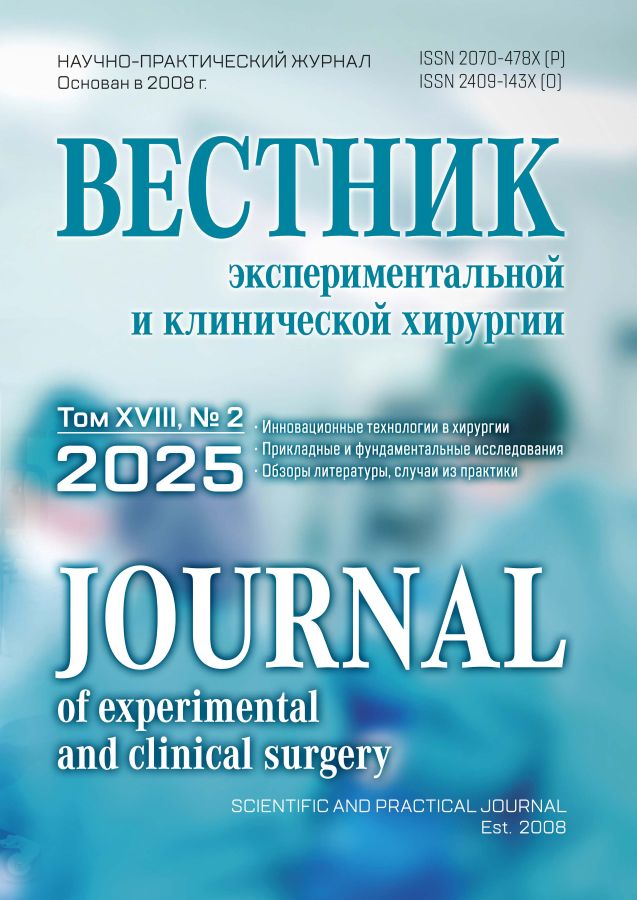Autologous Intestinal Reconstruction: What, When, and Why?
- Authors: Demidov S.K.1, Batyrshin I.M.2,3, Demko A.E.2,3, Luft V.M.2, Avetyan N.A.2, Fomin D.V.2, Ostroumova Y.S.2
-
Affiliations:
- Department No. 3 of the 1477th Naval Clinical Hospital
- Janelidze Saint Petersburg Research Institute of Emergency Medicine
- Kirov Military Medical Academy
- Issue: Vol 18, No 2 (2025)
- Pages: 116-130
- Section: Review of literature
- URL: https://vestnik-surgery.com/journal/article/view/1865
- DOI: https://doi.org/10.18499/2070-478X-2025-18-2-116-130
- ID: 1865
Cite item
Abstract
Post-resection short bowel syndrome, which is manifested as a severe intestinal failure, is a pressing medical and social problem due to persistent intestinal dyspepsia and progressive, sometimes life-threatening, malnutrition in these patients, leading to their early disability and long-term dependence on parenteral nutrition and maintenance infusion therapy. The introduction of modern parenteral nutrition technologies into clinical practice, which can be successfully carried out by patients self-dependently at home, has significantly changed the quality of life and ensured relatively long survival of the patients. However, parenteral nutrition can have a number of complications (catheter-associated bloodstream infection, venous thrombosis, hepatopathy, etc.), which requires a complex of therapeutic measures aimed at achieving enteral autonomy in these patients, significantly reducing or eliminating the need for intravenous support. One of the most essential areas that contributes to the achievement of enteral autonomy in this category of patients is autologous intestinal reconstruction surgery (AIRS).
The aim of the review is to summarize and systematize the accumulated current information on various options for surgical treatment of patients with post-resection short bowel syndrome and intestinal failure (SBS-IF) using various surgical techniques.
Keywords
Full Text
About the authors
Sergey K. Demidov
Department No. 3 of the 1477th Naval Clinical Hospital
Author for correspondence.
Email: Demidov9696@mail.ru
Senior Lieutenant at the Medical Service, Senior Resident at the Surgical Department
Russian Federation, Vilyuchinsk, Kamchatka TerritoryIldar M. Batyrshin
Janelidze Saint Petersburg Research Institute of Emergency Medicine; Kirov Military Medical Academy
Email: onrush@mail.ru
M.D., Head of the 11th Surgical Department
Russian Federation, Saint Petersburg; Saint PetersburgAndrey E. Demko
Janelidze Saint Petersburg Research Institute of Emergency Medicine; Kirov Military Medical Academy
Email: demkoandrey@gmail.com
M.D., Professor, Honored Doctor of the Russian Federation, Deputy Director for Scientific Work
Russian Federation, Saint Petersburg; Saint PetersburgValery M. Luft
Janelidze Saint Petersburg Research Institute of Emergency Medicine
Email: lvm_aspep@mail.ru
M.D., Professor, Honored Physician of the Russian Federation, Head of the Clinical Nutrition Department
Russian Federation, Saint PetersburgNorik A. Avetyan
Janelidze Saint Petersburg Research Institute of Emergency Medicine
Email: norikavetyan@mail.ru
Surgeon at the 11th Surgical Department
Russian Federation, Saint PetersburgDmitry V. Fomin
Janelidze Saint Petersburg Research Institute of Emergency Medicine
Email: doctordmitryfomin@yandex.ru
Ph.D., Surgeon at the 11th Surgical Department
Russian Federation, Saint PetersburgYulia S. Ostroumova
Janelidze Saint Petersburg Research Institute of Emergency Medicine
Email: yulia575091@yandex.ru
Ph.D., Surgeon at the 11th Surgical Department, Researcher at the Department of Surgical Infections
Russian Federation, Saint PetersburgReferences
- Lauro A, Coletta R, Morabito A. Restoring gut physiology in short bowel patients: from bench to clinical application of autologous intestinal reconstructive procedures. Expert Rev Gastroenterol Hepatol. 2019; 13:785– 96. doi: 10.1080/17474124.2019.1640600
- Wilmore DW, Dudrick SJ. Growth and development of an infant receiving all nutrients exclusively by vein. JAMA. 1968; 203:860–4. doi: 10.1001/jama. 1968.03140100042009
- Deltz E, Schroeder P, Gebhardt H, Gundlach M, Engemann R, Timmermann W. Ersteerfolgreicheklinische dünndarmtransplantation. Taktik und chirurgische technik. Chirurg. 1989; 60:235-9.
- Ramos-Gonzalez G, Kim HB. Autologous intestinal reconstruction surgery. Semin Pediatr Surg. 2018; 27: 261-6. doi: 10.1053/j.sempedsurg.2018.08.001
- Thompson JS. Surgical approach to the short-bowel syndrome: procedures to slow intestinal transit. Eur J Pediatr Surg. 1999; 9:263–6. doi: 10.1055/s2008-1072260
- Beyer-Berjot L, Joly F, Maggiori L, Corcos O, Bouhnik Y, Bretagnol F, et al. Segmental reversal of the small bowel can end permanent parenteral nutrition dependency: an experience of 38 adults with short bowel syndrome. Ann Surg. 2012; 256:739–44. doi: 10.1097/SLA.0b013e31827387f5
- Hutcher NE, Mendez-Picon G, Salzberg AM. Prejejunal transposition of colon to prevent the development of short bowel syndrome in puppies with 90 per cent small intestine resection. J Pediatr Surg. 1973; 8:771–7. doi: 10.1016/0022-3468(73)90420-x
- Sidhu GS, Narasimharao KL, Rani VU, Sarkar AK, Chakravarti RN, Mitra SK. Morphological and functional changes in the gut after massive small bowel resection and colon interposition in rhesus monkeys. Digestion. 1984; 29:47–54. doi: 10.1159/000199008
- Sidhu GS, Narasimharao KL, Usha Rani V, Sarkar AK, Mitra SK. Absorption studies after massive small bowel resection and antiperistaltic colon interposition in rhesus monkeys. Dig Dis Sci. 1985; 30:483–8. doi: 10.1007/ BF01318183
- King DR, Anvari M, Jamieson GG, King JM. Does the colon adopt small bowel features in a small bowel environment? Aust Iizuka N Z J Surg. 1996; 66:543–6. doi: 10.1111/j.1445-2197.1996.tb00806.x
- Kono K, Sekikawa T, H, Takahashi A, Amemiya H, Takehana T, et al. Interposed colon between remnants of the small intestine exhibits small bowel features in a patient with short bowel syndrome. Dig Surg. 2001; 18:237–41. doi: 10.1159/000050143
- Lloyd DA. Antiperistaltic colonic interposition following massive small bowel resection in rats. J Pediatr Surg. 1981; 16:64–9. doi: 10.1016/s0022- 3468(81)80118-2
- Howard ER, Othersen HB Jr. Proximal jejunoplasty in the treatment of jejunal atresia. J Pediatr Surg. 1973; 8:685–90. doi: 10.1016/0022-3468(73) 90407-7
- De Lorimier AA, Harrison MR. Intestinal plication in the treatment of atresia. J Pediatr Surg. 1983; 18:734–7. doi: 10.1016/s0022-3468(83)80 014-1
- Aigrain Y, Cornet D, Cezard JP, Boureau M. Longitudinal division of small intestine: a surgical possibility for children with the very short bowel syndrome. Z Kinderchir. 1985; 40:233–6. doi: 10.1055/s-2008-1059781
- Boeckman CR, Traylor R. Bowel lengthening for short gut syndrome. J Pediatr Surg. 1981; 16:996–7. doi: 10.1016/s0022-3468(81)80863-9
- Bianchi A. Longitudinal intestinal lengthening and tailoring: results in 20 children. J R Soc Med. 1997; 90:429–32. doi: 10.1177/014107689709000804
- Walker SR, Nucci A, Yaworski JA, Barksdale EM Jr. The Bianchi procedure: a 20-year single institution experience. J Pediatr Surg. 2006; 41:113–9. doi: 10.1016/j.jpedsurg.2005.10.015
- Hosie S, Loff S, Wirth H, Rapp HJ, von Buch C, Waag KL. Experience of 49 longitudinal intestinal lengthening procedures for short bowel syndrome. Eur J Pediatr Surg. 2006; 16:171–5. doi: 10.1055/s-2006-924251
- Reinshagen K, Kabs C, Wirth H, Hable N, Brade J, Zahn K, et al. Long-term outcome in patients with short bowel syndrome after longitudinal intestinal lengthening and tailoring. J Pediatr Gastroenterol Nutr. 2008; 47:573–8. doi: 10.1097/mpg.0b013e31816232e3
- Kim HB, Fauza D, Garza J, Oh JT, Nurko S, Jaksic T. Serial transverse enteroplasty (STEP): a novel bowel lengthening procedure. J Pediatr Surg. 2003; 38:425–9. doi: 10.1053/jpsu.2003.50073
- Chang RW, Javid PJ, Oh JT, Andreoli S, Kim HB, Fauza D, et al. Serial transverse enteroplasty enhances intestinal function in a model of short bowel syndrome. Ann Surg. 2006; 243:223–8. doi: 10.1097/01.sla.0000197704. 76166.07
- Kaji T, Tanaka H, Wallace LE, Kravarusic D, Holst J, Sigalet DL. Nutritional effects of the serial transverse enteroplasty procedure in experimental short bowel syndrome. J Pediatr Surg. 2009; 44:1552–9. doi: 10.1016/j.jpedsurg. 2008.10.001
- Piper H, Modi BP, Kim HB, Fauza D, Glickman J, Jaksic T. The second STEP: the feasibility of repeat serial transverse enteroplasty. J Pediatr Surg. 2006; 41:1951–6. doi: 10.1016/j.jpedsurg.2006.08.015
- Suri M, Dicken B, Nation PN, Wizzard P, Turner JM, Wales PW. . The next step? Use of tissue fusion technology to perform the serial transverse enteroplasty–proof of principle. J Pediatr Surg. 2012; 47:938–43. doi: 10. 1016/j.jpedsurg.2012.01.048
- Kim HB, Lee PW, Garza J, Duggan C, Fauza D, Jaksic T. Serial transverse enteroplasty for short bowel syndrome: a case report. J Pediatr Surg. 2003; 38:881–5. doi: 10.1016/s0022-3468(03)00115-5
- Javid PJ, Wendel D, Horslen SP. Organization and outcomes of multidisciplinary intestinal failure teams. Semin Pediatr Surg. 2018;27:218–22. doi: 10.1053/j.sempedsurg.2018.07.005
- Wales PW, de Silva N, Langer JC, Fecteau A. Intermediate outcomes after serial transverse enteroplasty in children with short bowel syndrome. J Pediatr Surg. 2007; 42:1804–10. doi: 10.1016/j.jpedsurg.2007.07.029
- Oh PS, Fingeret AL, Shah MY, Ventura KA, Brodlie S, Ovchinsky N, et al. Improved tolerance for enteral nutrition after serial transverse enteroplasty (STEP) in infants and children with short bowel syndrome–a seven-year single-center experience. J Pediatr Surg. 2014; 49:1589–92. doi: 10.1016/j. jpedsurg.2014.07.019
- Fernandes MA, Usatin D, Allen IE, Rhee S, Vu L. Improved enteral tolerance following step procedure: systematic literature review and meta-analysis. Pediatr Surg Int. 2016; 32:921–6. doi: 10.1007/s00383-016-3927-9
- Jones BA, Hull MA, Potanos KM, Zurakowski D, Fitzgibbons SC, Ching YA, et al. Data Registry. Report of 111 consecutive patients enrolled in the International serial transverse enteroplasty (STEP) data registry: a retrospective observational study. J Am Coll Surg. 2013; 216:438–46. doi: 10.1016/j.jamcollsurg.2012.12.018
- Ehrlich PF, Mychaliska GB, Teitelbaum DH. The 2 STEP: an approach to repeating a serial transverse enteroplasty. J Pediatr Surg. 2007; 42:819–22. doi: 10.1016/j.jpedsurg.2006.12.056
- Andres AM, Thompson J, Grant W, Botha J, Sunderman B, Antonson D, et al. Repeat surgical bowel lengthening with the STEP procedure. Transplantation. 2008; 85:1294–9. doi: 10.1097/TP.0b013e31817268ca
- Barrett M, Demehri FR, Ives GC, Schaedig K, Arnold MA, Teitelbaum DH. Taking a STEP back: assessing the outcomes of multiple STEP procedures. J Pediatr Surg. 2017; 52:69–73. doi: 10.1016/j.jpedsurg.2016.10.024
- Mutanen A, Barrett M, Feng Y, Lohi J, Rabah R, Teitelbaum DH, et al. Short bowel mucosal morphology, proliferation and inflammation at first and repeat STEP procedures. J Pediatr Surg. 2019; 54:511–6. doi: 10.1016/ j.jpedsurg.2018.04.016
- Sudan D, Thompson J, Botha J, Grant W, Antonson D, Raynor S, et al. Comparison of intestinal lengthening procedures for patients with short bowel syndrome. Ann Surg. 2007; 246:593–601. doi: 10.1097/SLA. 0b013e318155aa0c
- Miyasaka EA, Brown PI, Teitelbaum DH. Redilation of bowel after intestinal lengthening procedures–an indicator for poor outcome. J Pediatr Surg. 2011; 46:145–9. doi: 10.1016/j.jpedsurg.2010.09.084
- Shah AA, Petrosyan M, Franklin AL, Chahine AA, Torres C, Sandler AD. Autologous intestinal reconstruction: a single institution study of the serial transverse enteroplasty (STEP) and the longitudinal intestinal lengthening and tailoring (LILT). Pediatr Surg Int. 2019; 35:649–55. doi: 10.1007/s00383- 019-04468-3
- Frongia G, Kessler M, Weih S, Nickkholgh A, Mehrabi A, Holland-Cunz S. Comparison of LILT and STEP procedures in children with short bowel syndrome – a systematic review of the literature. J Pediatr Surg. 2013; 48:1794–805. doi: 10.1016/j.jpedsurg.2013.05.018
- King B, Carlson G, Khalil BA, Morabito A. Intestinal bowel lengthening in children with short bowel syndrome: systematic review of the Bianchi and STEP procedures. World J Surg. 2013; 37:694–704. doi: 10.1007/s00268-012- 1879-3
- Coletta R, Aldeiri B, Morabito A. Institutional experience with spiral intestinal lengthening and tailoring. Eur J Pediatr Surg. 2019; 29:412–6. doi: 10.1055/s-0038-1660850
- Fusaro F, Hermans D, Wanty C, Veyckemans F, Pirenne J, Reding R. Post-serial transverse enteroplasty bowel redilatation treated by longitudinal intestinal lengthening and tailoring procedure. J Pediatr Surg. 2012; 47:e19– 22. doi: 10.1016/j.jpedsurg.2012.05.023
- Cserni T, Takayasu H, Muzsnay Z, Varga G, Murphy F, Folaranmi SE. New idea of intestinal lengthening and tailoring. Pediatr Surg Int. 2011; 27:1009–13. doi: 10.1007/s00383-011-2900-x
- Mehrabi V, Mehrabi A, Jamshidi SH, Pedram MS, Sabagh MS, Jaberansari N, et al. Modified spiral intestinal lengthening and tailoring for short bowel syndrome. Surg Innov. 2016; 23:30–5. doi: 10.1177/1553350615596639
- Cserni T, Biszku B, Guthy I, Dicso F, Szaloki L, Folaranmi S. The first clinical application of the spiral intestinal lengthening and tailoring (silt) in extreme short bowel syndrome. J Gastrointest Surg. 2014;18:1852–7. doi: 10.1007/s11605-014-2577-2
- Collins J III, Vicente Y, Georgeson K, Kelly D. Partial intestinal obstruction induces substantial mucosal proliferation in the pig. J Pediatr Surg. 1996; 31:415–9. doi: 10.1016/s0022-3468(96)90750-2
- Murphy F, Khalil BA, Gozzini S, King B, Bianchi A, Morabito A. Controlled tissue expansion in the initial management of the short bowel state. World J Surg. 2011; 35:1142–5.
- Capriati T, Mosca A, Alterio T, Spagnuolo MI, Gandullia P, Lezo A. To wean or not to wean: the role of autologous reconstructive surgery in the natural history of pediatric short bowel syndrome on behalf of Italian society for gastroenterology, hepatology and nutrition (SIGENP). Nutrients. 2020; 12:2136. doi: 10.3390/nu12072136
- Aver'yanova YuV, Batyrshin IM, Demko AE, Ivanova GE, Ivashkin VT, Kostyuchenko LN, Lapitskii AV, Leiderman IN, Luft VM, Maev IV, Nikitin IG, Novruzbekov MS, Poluektova EA, Potapov AL, Sytov AV, Trukhmanov AS. Clinical recommendations of the Northwestern Association of Parenteral and Enteral Nutrition, the Interregional Association for Emergency Surgery, the Russian Gastroenterological Association, the Union of Rehabilitologists of Russia and the Russian Transplantation Society for the Diagnosis and Treatment of short Bowel Syndrome with Intestinal Insufficiency in adults.. Rossiiskii zhurnal gastroenterologii, gepatologii, koloproktologii. 2022;32(1):60-103.
- Kelly DG, Tappenden KA, Winkler MF. Short bowel syndrome: highlights of patient management, quality of life, and survival. JPEN J Parenter Enteral Nutr. 2014; 38(4):427-437.
Supplementary files




















